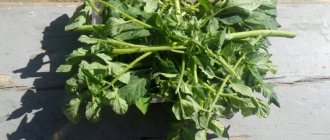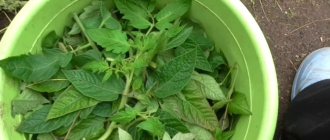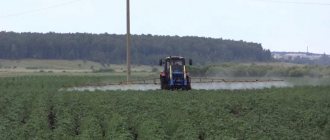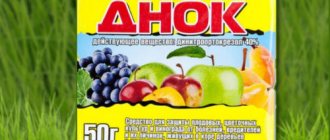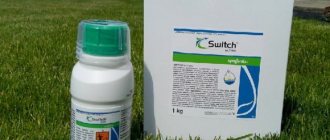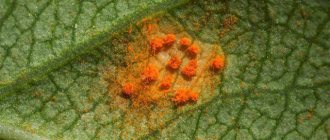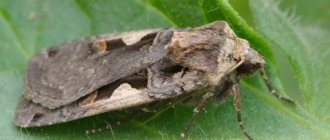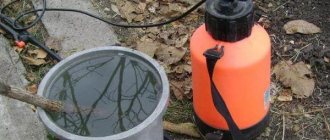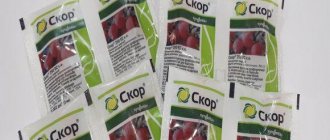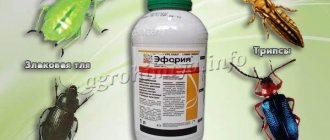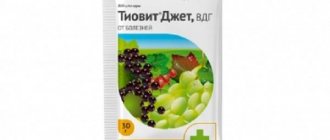"Abiga-PIK" is a well-known fungicide that is used to combat all known fungal plant diseases.
The main effect of the drug is the inhibition of the most important vital functions of bacteria and fungi, reducing their ability to enter a spore-like state and “wait out” the treatment time. Dear readers!
For you, we have created communities on social networks in which useful articles and interesting ideas are published several times a day! Subscribe and receive useful content in a convenient format! It has long been noted that “Abiga-PIK,” although it is a chemical preparation, is still distinguished by its versatility and relative softness. Its correct use does not lead to “contamination” of the crop with heavy chemical elements harmful to human health.
Description of the drug, its characteristics and composition
The main active ingredient in Abiga-PIK is a copper compound - copper oxychloride. It is copper that has a pronounced inhibitory effect on unwanted fungal flora.
1 liter of standard solution in packaged containers contains 40% copper oxychloride.
The product is sold in different forms:
- 12.5 liter canisters - for large agricultural complexes.
- Small containers of 50 ml or 1.25 l.
An important feature is that the drug can only be used diluted . Moreover, first the required dosage is diluted (we will talk about this later for each crop separately) in 1 liter of water, and then the resulting mixture is additionally diluted in a 10 liter container.
Only then do they begin to process the plants.
Preparation of the solution
For this purpose, any utensils for household purposes are used, except metal ones. A plastic or enamel bucket is best. The product should be diluted before starting the spraying process.
First of all, prepare the mother base or mash. A bottle with a 50 g suspension is shaken until a homogeneous structure is obtained. The opaque suspension is diluted with one liter of water at room temperature and left for a short time to dissolve the chemicals. Then add the required amount of water and mix thoroughly. The resulting working solution is 0.5% with a volume of 10 liters.
In what cases is the use of Abiga-PIK prescribed?
In modern gardening, Abiga-PIK is used quite often. It is mainly used to prevent fungal diseases. But it also helps in the fight against their development, including at an extremely advanced stage.
The three most important rules for use:
- Do not use in pure form.
- Strictly observe breaks between treatments.
- Do not apply 2-3 weeks before harvest.
Otherwise, the product is considered to be quite mild, not deposited by heavy chemical elements in fruits and roots, but at the same time extremely effective.
What diseases does the remedy work for?
"Abiga-PIK" is a fungicide that has proven itself for use against a wide range of diseases of fungal origin on all types of plants (including fruit and vegetable crops).
The main active ingredient in the composition is copper oxychloride. When contact processing the surface of plants, a film with a high copper content is formed on them. Copper interacts with fungi and bacteria and affects them in such a way that the processes of protein metabolism and spore formation slow down in them.
At the same time, in normal, recommended dosages, “Abiga-PIK” does not in any way affect the taste and quality of plant fruits.
REFERENCE. In agriculture and private gardening, the drug is successfully used to treat fruit and vegetable crops, ornamental plants, vineyards, field lands, and forests.
Maximum effectiveness has been proven against the following common fungal diseases:
- anthracnose;
- powdery mildew;
- bacteriosis;
- white rust;
- brown spot;
- black spot;
- moniliosis;
- mildew;
- oidium;
- scab;
- peronosporosis;
- late blight;
- fusarium;
- cercospora blight
Phytophthora on tomatoes
By the way, an important point: “Abiga-PIK” and many of its analogues are harmless to bees.
The product has proven itself best in the form of preventive treatments, as well as in the early stages of development of the fungal population.
Mechanism of action of the drug
When the fungicide gets on the plants, copper begins to be actively released, which interacts with fungal pathogens. As a result of suppressing the vital activity of pathogenic pests, the process of sporulation slows down. After spraying in accordance with the dosages specified in the instructions for use of the Abiga-Pik fungicide, a protective film is formed on the surface of beneficial crops, which prevents the further spread of infection. Copper oxychloride does not penetrate into fruits and berries and does not impair their taste and quality characteristics.
Important! Provided that the dosages specified in the instructions are observed, the viability of microorganisms decreases under the influence of the active substance as a result of blocking the functions of respiration and growth.
Features of the Abiga-Pik fungicide:
- the use of a drug containing copper more often than indicated in the instructions may lead to a slowdown in the growth of some vegetable crops;
- the product has a low phytotoxicity index and is moderately dangerous.
The safety of the Abiga-Pik fungicide makes it possible to use it to protect the following crops:
- vegetables;
- grapes;
- strawberries;
- stone fruit and pome fruit trees;
- colors;
- technical plants.
In accordance with the instructions, the use of the Abiga-Pik fungicide is effective in combating plant diseases of fungal origin, such as bacteriosis, fusarium, downy mildew, scab, powdery mildew, moniliosis, oidium, cercospora, late blight, mildew, and anthracnose.
To make the result of using the Abiga-Pik fungicide more effective, plants should be treated at the initial stage of the disease. Pathogenic pests overwinter in the upper layers of the soil. With the arrival of spring, along with the evaporation of moisture contained in the soil, pathogens rise into the air and, having encountered the first obstacle in their path in the form of leaves, settle on their lower surface.
When using the Abiga-Pik fungicide in dosages corresponding to the instructions, it is necessary to treat the foliage from all sides, especially from the bottom. Spraying is carried out until drops appear on the green surface, after which they begin pollinating neighboring crops.
Instructions for using the fungicide “Abiga-PIK” for different plants
The most important part is preparing a solution from the purchased Abiga-PIK drug. Precisely a solution, because in its normal state the concentration of the active substance will be very high and can destroy the plants.
ADVICE . In the case of Abiga-PIK, it is not recommended to dilute the mixture in iron containers, as chemical reactions may occur, as a result of which compounds dangerous to humans will later settle in the fruits of the plants.
“Abiga-PIK” is diluted in plastic or glass containers. Two important principles are followed:
- First, the concentrate is diluted in 1 liter of water , stirred well, and allowed to stand for a little while.
- Then add clean water to the mixture until approximately a 10-liter bucket is filled . The desired solution is obtained with a consistency of approximately 0.5%.
The resulting solution is sprayed onto the plants. They try to hit all above-ground parts and capture the surface of the soil.
There are no differences in the consistency of the Abiga-PIK solution - it is approximately the same for all types of treatment. It is much more important to observe the frequency of treatments and the required breaks between them. Here, different cultures may have their own characteristics.
How to use for grapes? (will help with powdery mildew, mildew, spotted anthracnose)
A slightly lower concentration is recommended (40 grams of product per 10 liters of water). But it is also possible to use the standard version.
Spraying should be carried out most actively at high humidity in the warm season. For the entire growing season - up to 6 times a year. Between treatments - at least 2 weeks break.
21 days before harvest, application of the product is completely stopped.
How to dilute cabbage?
It is not recommended to use for cabbage, as some unsafe substances may accumulate in its head.
How to use for cucumbers? (will help with penosporosis, anthracnose, bacteriosis)
Cucumbers need no more than 3 treatments with a standard solution. In this case, it is advisable that Abiga-PIK not be used at all during the flowering period.
Application for tomatoes (will help with late blight, brown spot, alternaria)
You need to use a 0.4 or 0.5 percent solution. Up to 4 treatments are carried out per year. Preferably no more than this number.
The first begins after 2-3 weeks from planting the seedlings. Then, at intervals of 2-3 weeks, they process further. It is no longer worth spraying tomatoes 14-20 days before harvest.
Use for strawberries (will help with brown spotting, white spotting)
The standard mixture is used strictly before flowering and after harvesting. Breaks between treatments are at least 3 weeks.
How to breed for indoor flowers? (will help with white rust, brown spot)
The standard mixture is treated approximately 2 times a year. More is not recommended.
You need to spray strictly in a well-ventilated area and leave the flowers there for at least a day. Only then return it to the house to its permanent place.
For garlic and onions
Garlic and onions are suitable for treatment tactics no more than three times a year. Moreover, it is important to remember that this fungicide cannot be used when growing onions.
For garden flowers: roses (against spotting, rust)
“Abiga-PIK” can be used with all decorative garden flowers. But the product has proven itself especially well with roses.
For work, take a standard mixture of 50 grams. of the drug diluted in 10 liters. water. 2 treatments per season are enough.
How to breed for fruit trees? (will help with scab, moniliosis)
A standard solution (0.5%) is taken. Both trees and fruit bushes can be treated.
No more than 4 applications before harvest are recommended. The first two are before the formation of the cutting funnel. The second two are after flowering as the fruits ripen.
Consumption of the drug for plants
For most crops, the standard concentration of the working solution is used - 50 ml of suspension per 10 liters of water. It is also necessary to take into account the diseases that affect plants.
Table 3
Workforce concentration
| Diseases | Which plants are affected? | Suspension consumption, in ml per 10 l of water |
| Anthracnose, mildew, oidium | Vineyards | 40 |
| Bacteriosis, peronosporosis | Cucumbers, onions | 50 |
| Alternaria, late blight | Potatoes, tomatoes, sweet peppers, eggplants | |
| Cercospora | Beet | |
| Scab, moniliosis | Pears, apple trees | |
| Coccomycosis, leaf curl | Cherries, apricots, peaches, plums | 45-50 |
| Brown spot, white rust | Decorative plants and flowers |
If we take into account the size of the treated area, then the average rate of working staff per 1 sq.m. – 50 ml. This consumption makes the drug Abiga-pik economical - one bottle is enough to spray a large number of plants.
How quickly does Abiga-PIK begin to act?
The product begins to have a direct effect on harmful fungal flora within the first 2-3 hours.
Interestingly, after application, a kind of protective shell of copper compounds is formed on the plants, which then allows the plants to maintain excellent immunity to repeated fungal infections for a long time.
INFORMATION: “Abiga-PIK” is not washed off for a long time by rain and watering. It can be used near bodies of water without fear of clogging the soil and water.
What analogues are there?
There are a large number of products on the market that are completely identical or similar in properties and composition to the Abiga-PIK fungicide. Among them:
- "Medex";
- "Kuproksat";
- "Oxychom";
- "Horus."
If suddenly you can’t find exactly “Abiga-PIK”, then these analogues can be used without fear. Their effectiveness will also be at the same level.
PEOPLE'S ADVICE: Bordeaux mixture has a roughly similar mechanism of action on plants, fungi, and harmful bacteria.
Pesticide analogues and compatibility with other drugs
Pesticides with a similar principle of operation, which contain the same active substance:
- Bordeaux mixture.
- Cuproxat.
- Oksikhom.
- Ordan.
- Horus.
- Kurzat.
- Medex.
Causes of yellowing leaves in plants
All these chemicals are widely used in dachas, gardens and orchards.
The drug is a universal remedy for overcoming plant diseases. The main difference between Abiga Peak is its compatibility with most pesticides and insecticides. If, when using several drugs, a white precipitate or coating appears and the solution becomes cloudy, then these two products cannot be used.
Precautions for use
"Abiga-PIK" is a drug with an assigned partial hazard class. In principle, it is considered relatively safe for humans and beneficial insects. However, it is better to carry out treatments in the morning or evening so that the effect on the bees is minimal (bees can be released 12 hours after spraying).
When processing plants, you also need to take all precautions:
- Protect hands, eyes and respiratory organs with personal protective equipment.
- Do not eat or drink water.
- Ensure a safe distance from the treatment site for children and animals.
Upon completion of processing: Wash PPE in warm running water and soap, wash hands, wash, and if possible, take a shower.
Safety and Precautions
"Abiga-Peak" belongs to chemicals of the third class of toxicity, and therefore is practically harmless to the environment
However, when working with it you still need to take precautions:
- wear a respirator, gloves, safety glasses;
- do not allow contact with skin or mucous membranes;
- do not dilute the working solution in food preparation containers;
- remove children and pets at least 15 m from the work area;
- Thoroughly wash exposed areas of the body after finishing treatment.
If the drug gets on the skin or eyes, the area should be rinsed with plenty of water. If ingested, you should drink an absorbent and immediately consult a doctor.
Author's advice
To work with the solution you will need:
- breathing mask or respirator;
- protective glasses;
- gloves, always rubber;
- closed clothing with long sleeves.
Advantages and disadvantages of the product
The Abiga-PIK product has many advantages. Among the main ones we note:
- Availability of the product - it is freely sold.
- Easy to prepare - “Abiga-PIK” can be easily diluted in ordinary water and then applied to the crops being treated.
- Possibility to use the product in any weather.
- Stability of the active substance in the drug to low temperatures.
- The product is not washed off during rainfall, is not washed into the ground, and the main effect is felt for at least another 10-20 days from the date of treatment.
- The drug is classified as low toxic. It is known that its use has almost no effect on the chemical composition of plant fruits.
- Even a diluted product is stored well and for a long time without losing its properties.
- Low level of resistance (addiction) on the part of plants.
- Minimal resistance to the active substance in Abiga-PIK from microorganisms and fungi.
- A particularly good effect is felt when used for prevention, as well as during the growing season, gaining green mass.
- The product promotes increased production of chlorophyll in plants.
- "Abiga-PIK" is a low-toxic drug for pollinating insects.
And the main disadvantages include:
- Exceeding dosages and violating the technology of treatments (in particular, breaks between them or using an undiluted product) can lead to a slowdown in the growth of cultivated plants.
- Excessive use can also lead to the accumulation of copper in plant fruits - this leads to a negative impact on the health of people who eat such fruits.
- There are certain difficulties associated with use, since it is still necessary to take full measures to protect the eyes, respiratory organs, mucous membranes, and open areas of the skin.
Composition, action, purpose
The chemical formula of copper oxychloride (otherwise, copper(II) chloride, copper chloride) is CuCl2 nH2O - a salt of hydrochloric acid.
Copper-containing compounds are used in horticulture against a wide range of pathogens. Abiga-Pik belongs to the category of contact drugs that have a detrimental effect on spores of fungal pathogens, as well as bacteria.
The active substance, when interacting with microorganisms, is converted into the active form of copper, which inhibits the synthesis of amino acids necessary for the synthesis of proteins. As a result, pathogens cannot develop normally and die.
The fungicide is effective against a wide range of plant diseases because:
- Powdery mildew on different types of crops,
- Many types of spots,
- Anthracnose,
- Bacteriosis,
- Late blight,
- Mildew (powdery mildew of grapes),
- Oidium (downy mildew of grapes),
- Scab on pear and apple trees,
- Downy mildew,
- Moniliosis,
- Fusarium,
- Cerconosporosis,
- Types of rust and some others.
Without restrictions, it is used for all types of garden, fruit and berry and ornamental plants.
Positive properties of the drug:
- It gives the best results in preventive protection and treatment in the initial stage of infection;
- Operates in different weather conditions, even low temperatures;
- The likelihood of resistance is relatively low;
- It adheres well to the surface of plants, ensuring economical use of the product;
- Not washed away by precipitation and watering;
- The fungicide is easy to prepare for use.
- The working solution can be stored for a long time, which will not affect its medicinal properties.
One of the greatest advantages is effective use at low temperatures; the effect is observed at +90.
Negative features of the drug include mandatory compliance with the solution concentration and processing standards. Oversaturation leads to the accumulation of harmful substances in fruits.
Common mistakes
Although this drug is relatively mild and low-toxic, a number of errors can be identified from its use.
- Dosages are too large - Abiga-PIK can only be used diluted.
- Too frequent application - treatments should be carried out with breaks of at least 14 days between them.
- Application during flowering and budding - in general, this is not recommended.
- Application until the very moment of harvesting - treatment should be stopped 20 days before fruiting.
- Plants should be treated with a sprayer over the entire area, capturing the soil underneath them.
Answers to popular questions
When can you start using Abiga-PIK?
From early spring, when the plant has taken root well on the ground.
Can it be used during flowering and budding?
Undesirable for most garden crops.
Is it possible to use Abiga-PIK with other products or fertilizers?
Yes it is possible.
What is the most important thing in using the drug?
Follow the recipe. And treat the plants exactly as many times a year as recommended.
Conclusion
"Abiga-PIK" is an effective remedy in the fight against fungal plant diseases. In addition, it is accessible, freely sold, easily diluted to the desired consistency, and stores well. And if we add to this the proven fact of safety for human health (with recommended use, of course), then the drug can be called one of the mandatory ones in the process of growing all types of cultivated plants.
In any case, adopting the knowledge of using Abiga-PIK will not be superfluous for any gardener.
